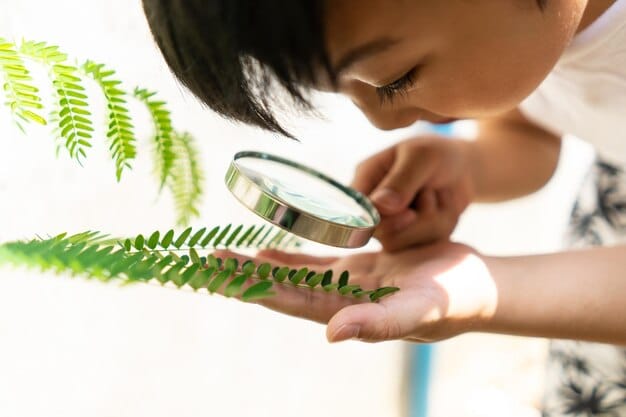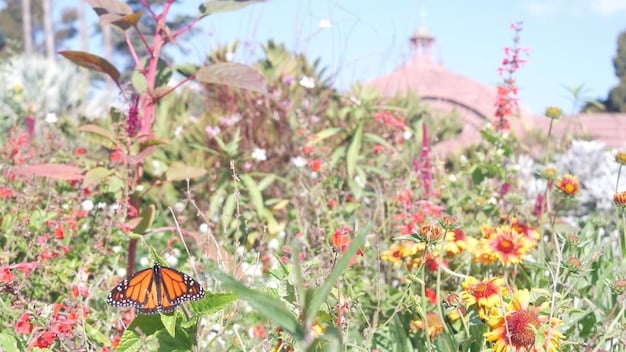Family Nature Walk: Identify 7 Plants & Animals Near You

Embark on a family nature walk: identify 7 common plants and animals in your area and transform an ordinary outing into a captivating learning adventure, fostering a deeper connection with the natural world.
Embarking on a nature walk as a family is more than just a pleasant stroll; it’s an opportunity to connect with the environment, learn about the flora and fauna around you, and create lasting memories. The best part? You don’t need to be an expert naturalist to enjoy and benefit from a family nature walk: identify 7 common plants and animals in your area. With a bit of preparation and curiosity, you can transform an ordinary outing into an engaging and educational adventure for the whole family.
Preparing for Your Family Nature Walk
Before you head out, a little preparation can go a long way in ensuring an enjoyable and educational experience. Consider the location, the time of year, and the ages of the children participating to tailor the walk to your family’s needs and interests.
Choosing the Right Location
Select a location that offers a variety of habitats and is easily accessible. Local parks, nature reserves, or even your own backyard can be excellent choices. Look for trails that are well-maintained and suitable for all fitness levels.
Timing is Everything
The time of day and year can significantly impact the types of plants and animals you’re likely to encounter. Spring and fall often offer the most diverse displays of flora and fauna, while early morning or late afternoon walks can increase your chances of spotting wildlife. Check the weather forecast and dress appropriately.
Here are some more points to consider:
- Pack a backpack with essentials: water, snacks, sunscreen, insect repellent, a first-aid kit, and a map of the area.
- Bring tools for observation: binoculars, magnifying glasses, and field guides can enhance your ability to identify plants and animals.
- Encourage curiosity: ask open-ended questions, such as “What do you think this plant is used for?” or “Why do you think this animal lives here?”
- Set ground rules: emphasize the importance of respecting the environment and avoiding disturbing plants or animals.
By planning carefully and engaging your children’s curiosity, you can create a memorable and educational nature walk experience.

Identifying Common Trees
Trees are a fundamental part of any ecosystem, providing shelter, food, and oxygen. Learning to identify common trees in your area can deepen your appreciation for the natural world and provide a foundation for understanding the interconnectedness of life.
Leaf Shape and Arrangement
One of the easiest ways to identify trees is by examining their leaves. Pay attention to the shape, size, and arrangement of leaves on the branches. Are the leaves simple or compound? Are they arranged alternately, oppositely, or in whorls?
Bark Characteristics
The bark of a tree can also provide valuable clues to its identity. Note the color, texture, and pattern of the bark. Is it smooth or rough? Does it have ridges, plates, or scales? Collect bark rubbings for later comparison.
Here are some common trees you might encounter:
- Oak: Characterized by lobed leaves and acorns.
- Maple: Recognizable by its opposite leaf arrangement and winged seeds (samaras).
- Pine: Identified by its needle-like leaves and cones.
By observing the unique characteristics of leaves and bark, you can begin to identify the common trees in your area and understand their roles in the ecosystem.
Spotting and Identifying Common Birds
Birds are fascinating creatures that add beauty and song to our natural landscapes. Learning to identify common birds in your area can be a rewarding experience, enhancing your connection with nature and deepening your understanding of avian ecology.
Visual Cues
Start by observing the bird’s overall appearance. Note its size, shape, and coloration. Pay attention to distinctive markings, such as stripes, spots, or crests.
Auditory Cues
Bird songs and calls can be just as informative as visual cues. Listen carefully to the sounds the bird makes. Is it a melodious song, a harsh call, or a series of chirps?
Here are some common birds you might encounter:
- Robin: Known for its red breast and cheerful song.
- Cardinal: Identified by its bright red plumage (males) and distinctive crest.
- Blue Jay: Recognizable by its blue, black, and white feathers and raucous call.
Identifying birds by sight and sound can be a fun and educational activity for the whole family, fostering a greater appreciation for avian diversity and behavior.

Discovering Wildflowers
Wildflowers add vibrant color and delicate beauty to our natural landscapes. Learning to identify common wildflowers in your area can be a delightful way to connect with nature and appreciate the intricate details of plant life.
Flower Color and Shape
One of the first things to notice about a wildflower is its color. Is it red, orange, yellow, green, blue, indigo, or violet? Also, observe the shape of the flower. Is it bell-shaped, daisy-like, trumpet-shaped, or irregular?
Leaf Characteristics
The leaves of a wildflower can also provide clues to its identity. Note the shape, size, and arrangement of the leaves. Are they simple or compound? Are they arranged alternately, oppositely, or in whorls?
Here are some common wildflowers you might encounter:
- Daisy: Characterized by its white petals and yellow center.
- Dandelion: Known for its bright yellow flower and toothed leaves.
- Clover: Identified by its three-lobed leaves and round flower head.
By observing the color, shape, and leaf characteristics of wildflowers, you can begin to identify the common species in your area and appreciate their beauty and ecological importance.
Recognizing Common Insects
Insects are often overlooked, but they play crucial roles in our ecosystems, from pollination to decomposition. Learning to identify common insects in your area can open your eyes to the fascinating world of entomology and deepen your understanding of ecological relationships.
Body Structure
Insects typically have a three-part body: head, thorax, and abdomen. Observe the overall shape and size of the insect’s body. Does it have wings? If so, how many? What is the shape and venation of the wings?
Coloration and Markings
Insects come in a wide variety of colors and patterns. Note the insect’s overall coloration and any distinctive markings, such as stripes, spots, or bands.
Here are some common insects you might encounter:
- Butterfly: Characterized by its colorful wings and slender body.
- Bee: Identified by its fuzzy body and buzzing sound.
- Ant: Recognizable by its small size and social behavior.
By observing the body structure, coloration, and behavior of insects, you can begin to identify the common species in your area and appreciate their ecological roles.
Finding Evidence of Mammals
Mammals can be elusive creatures, but their presence is often revealed through tracks, scat, and other signs. Learning to identify these signs can provide insights into the mammals that inhabit your area and their behavior.
Tracks
Mammal tracks can vary greatly in size, shape, and pattern. Note the number of toes, the presence or absence of claws, and the overall size of the track. Consult a field guide to compare your observations.
Scat
Mammal scat (droppings) can also provide clues to their identity. Note the size, shape, and composition of the scat. Is it round, cylindrical, or segmented? Does it contain fur, bone, or seeds?
Here are some common mammals you might encounter (or find evidence of):
- Squirrel: Look for small, five-toed tracks and scattered nut shells.
- Deer: Identify by their cloven-hoof tracks and oval-shaped scat.
- Rabbit: Recognize by their paired tracks and round, pellet-like scat.
By learning to identify mammal tracks and scat, you can gain a better understanding of the mammals that live in your area and their interactions with the environment.
Exploring Aquatic Life
If your nature walk takes you near a stream, pond, or lake, take some time to explore the aquatic life. From insects and amphibians to fish and reptiles, there is a wealth of fascinating creatures to discover.
Observe from the Bank
Start by observing the water from the bank. Look for signs of life, such as insects skimming across the surface, fish swimming near the shore, or frogs basking in the sun.
Use a Dip Net
If permitted, use a dip net to collect samples of aquatic life. Gently scoop up water and sediment and examine the contents in a clear container. Identify any insects, crustaceans, or other invertebrates you find.
Here are some common aquatic creatures you might encounter:
- Dragonfly Nymph: Characterized by its elongated body and large eyes.
- Frog Tadpole: Identified by its rounded body and long tail.
- Water Strider: Recognizable by its long legs and ability to walk on water.
Exploring aquatic life can provide valuable insights into the health of the ecosystem and the interconnectedness of terrestrial and aquatic environments. Remember to always return any creatures you collect to their habitat.
| Key Point | Brief Description |
|---|---|
| 🌳Tree Identification | Identifying trees through leaf shape and bark characteristics. |
| 🐦 Bird Spotting | Recognize birds by visual and auditory cues. |
| 🦋Insect Recognition | Identifying common insects by body structure and color. |
| 🐾 Mammal Tracking | Finding and identifying mammal tracks and droppings. |
Frequently Asked Questions
Early morning or late afternoon are ideal due to cooler temperatures and increased wildlife activity. These times offer better chances to spot animals like birds and mammals.
Essentials include water, snacks, sunscreen, insect repellent, a small first-aid kit, binoculars, magnifying glasses, and field guides. A backpack is handy for carrying everything.
Emphasize not disturbing plants or animals, staying on marked trails, and leaving no trash behind. Explain the importance of preserving nature for future generations.
Start with the leaves. Note their shape, size, and arrangement on the branches. Also, examine the tree’s bark for color, texture, and patterns, which can provide additional clues.
Look at the size, shape, and pattern of the tracks. Note the number of toes and the presence of claws. A field guide can assist in matching the track to a specific animal.
Conclusion
Embarking on a family nature walk: identify 7 common plants and animals in your area is more than just a fun activity; it is an opportunity to connect with nature, learn about the environment, and create lasting memories. By following the guidelines outlined in this article, you can transform an ordinary outing into an engaging and educational experience for the whole family, fostering a deeper appreciation for the natural world.





